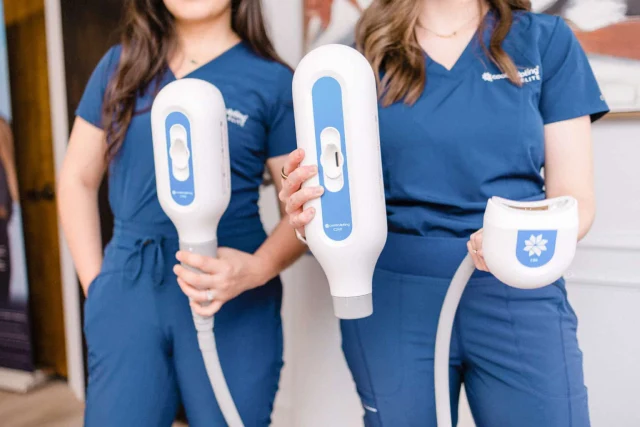When considering a non-surgical fat reduction treatment like CoolSculpting, it’s important to understand not only the benefits but also the potential risks. One of the rare side effects of CoolSculpting is Paradoxical Adipose Hyperplasia (PAH), and while it’s uncommon, it’s something that should be discussed openly with your provider. In this blog, we’ll explore what CoolSculpting PAH is, how it happens, and what can be done if you experience it.
Before diving in, it’s crucial to note that this blog is designed to be educational, not a substitute for a medical opinion or a statement on behalf of AbbVie, the manufacturers of CoolSculpting technology. If you have specific concerns or questions about the treatment, we encourage you to book a one-on-one consultation with our team at Element Body Lab in Dallas, TX, to discuss how CoolSculpting works and better understand all potential risks and side effects before pursuing the procedure or learn more about CoolSculpting side effects and recovery here.

Side Effects from CoolSculpting PAH – Paradoxical Adipose Hyperplasia
CoolSculpting is a popular and FDA-cleared non-invasive fat reduction treatment that uses cryolipolysis to target and freeze fat cells, causing them to gradually die off and be eliminated by the body. While most people experience noticeable fat reduction in the treated areas, a very small number of patients experience an unusual and opposite reaction—Paradoxical Adipose Hyperplasia (PAH). Learn more about coolsculpting side effects and recovery.
PAH is a rare side effect where the treated area actually increases in size rather than decreases. Instead of the fat shrinking, the area becomes larger, firmer, and more noticeable. While PAH doesn’t pose a health risk, it can be distressing for those expecting a slimmer contour, as the condition alters the appearance of the treatment area.
CoolSculpting PAH – Paradoxical Adipose Hyperplasia: What Does PAH Look Like from CoolSculpting?
Visually, PAH presents as an enlargement in the treated area, with the affected tissue appearing firmer than the surrounding untreated areas. Read that again, it’s only the tissue treated, not across the entire body. That said, PAH can be an unexpected outcome for clients seeking fat reduction and can lead to frustration since the results are not what was intended.

How Many People Get PAH from CoolSculpting?
Fortunately, Paradoxical Adipose Hyperplasia is very rare. According to data reported by Allergan (now AbbVie), PAH occurs in only about 0.03% of all CoolSculpting treatments. While this number is extremely low, it’s important to be aware that there may be additional unreported cases, so understanding this potential side effect is vital before starting treatment. Learn more about coolsculpting side effects and recovery.
How Does Paradoxical Adipose Hyperplasia Happen?
While the exact cause of PAH is still not fully understood, it is thought to occur when the body responds to the cooling process by producing more fat cells instead of eliminating them. The treated area can then grow larger and more solid due to this overcompensation. This condition contrasts with the typical CoolSculpting result, where fat cells are frozen and naturally metabolized by the body.
Who Is Most Likely to Get Paradoxical Adipose Hyperplasia?
PAH can occur in anyone undergoing CoolSculpting treatment, though no clear clinical patterns have emerged that indicate why it happens in certain patients. There are anecdotal reports suggesting that Latin Male clients may be more prone to developing PAH, but this information has not been verified through scientific research. As it stands, there’s no way to predict who might experience this rare side effect.
How to Get Rid of Paradoxical Adipose Hyperplasia
The only known solution for treating PAH is to surgically remove the excess tissue through liposuction. Because PAH is purely aesthetic and not harmful to your health, it’s generally recommended to wait at least six months before undergoing any corrective procedures. This waiting period allows the fat cells to stabilize, making surgery more effective.
At Element Body Lab, we take the safety and satisfaction of our clients very seriously. If you are treated in our facility and experience PAH, we’ll work with you to find the best treatment plan moving forward. In cases requiring surgical repair, we refer clients to Dauwe Plastic Surgery in Dallas, TX, who specialize in correcting this rare side effect. Additionally, Allergan has a policy in place to assist clients experiencing PAH, ensuring that you’re supported throughout the process.

Final Thoughts on Paradoxical Adipose Hyperplasia
While Paradoxical Adipose Hyperplasia is a rare side effect of CoolSculpting, it’s essential to be informed about all possible outcomes before committing to treatment. PAH is uncommon, but it’s a reminder of why it’s important to consult with trained and experienced professionals who can discuss all aspects of the procedure, including potential risks. Learn more about coolsculpting side effects and recovery.
At Element Body Lab, we prioritize transparency, safety, and individualized care. If you’re considering CoolSculpting and want to learn more about how it works and the possible side effects, including PAH, we encourage you to book a consultation with our expert team. Our trained specialists will help you navigate the decision and create a treatment plan tailored to your goals.

